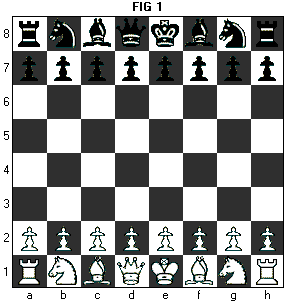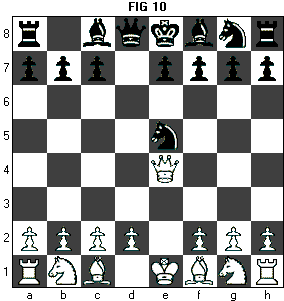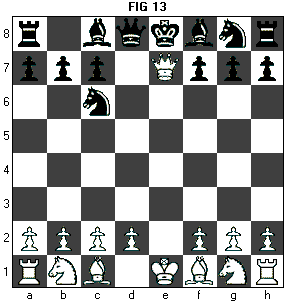Ven Chess
(© Graham Smith 2004 Patent Pending)
The Game
Using standard chess moves and any variations listed below place ones opponent in checkmate.
Intended moves (orders) are written simultaneously.
These orders are carried out in turn with each opponent moving first in alternate rounds.
Number of players: 2.
Equipment: Standard chessboard.
Board set up: Pieces arranged as for a standard chess game.

Rules of Play
Sequence of Play
Orders
An order is a planned movement of a chess piece. It is written in standard chess notation with the additional option of vengeance moves (see later) represented by a small v e.g. Qd2 v f2.
Players write an order at the same time as their opponent.
An order must be a valid chess move at the time of writing it or an avenging move.
Orders are written in secret from opponents.
Orders are revealed at the same time. This can be by agreement or after a fixed time period. The time period is to be agreed upon before play starts.
Failure to write an order will lead to forfeit of the game.
Movement
The player playing white carries out their orders first in the opening round, that is to say although the orders are revealed simultaneously white physically moves first.
Moving the ordered piece to the ordered square carries out the order or nothing is moved initially if an avenging move has been ordered.
A set of orders, one for white and one for black, followed by the movement of these orders is a round.
White moves first on the first round.
So whites order is carried out in to the movement of the piece on the board.
This is followed by blacks order being carried out.
Black moves first on the second round followed by white.
Moving first alternates on each subsequent round.
Vengeance Moves
A piece under threat of capture may be avenged by a piece able to defend the piece under attack, irrespective of whose move first it is.
One outcome is the piece under attack is captured and the opponent's capturing piece is subsequently captured by the avenging piece.
If no attack comes the vengeance move is void.
The vengeance move is denoted by a v in chess notation
E.g. Fig. 2 White orders Nxe5.
Black orders d6 v e5 (avenging any capture on e5).
With the following result (Fig. 3); it does not matter whose movement phase it is first.


In the example Fig. 4.
White orders c3.
Black orders d6 v e5.
Fig. 5 shows the outcome of the movement phase with blacks move being void.


Crossing
Pieces may not cross on the same rank column or file or diagonal. The piece moving second captures the opponents piece on the square it reached and it remains on the capturing square. In the example below (Fig. 6), black, to move first, orders e5; see Fig. 7. White orders Qxe7 but the resultant move is Fig. 8, Qxe5.



If a piece moving second is blocked, it takes the blocking piece and remains on the blocking piece's square.
In the example (Fig 9), black, to move first, orders Ne5. Fig. 10. White orders Qxe7. Fig. 11 is the result with Qxe5.



Fig. 12, Fig. 13, and Fig. 14 show the same sequence of orders as Fig. 9, Fig. 10 and Fig. 11 if white were to move first.



Void moves
A player forfeits the movement phase for a round for the following reasons:
If a piece is captured by an opponent who moved first and had an order to move that round.
If an avenging piece is not captured then the vengeance action is void.
An opponent moving first and occupying the square in front of the pawn forward can block pawn's movement.
If it is your movement second and your opponents piece has moved that turn from a square you were attacking with a pawn.
Castling moving second, an opponent moving first, moves their piece to the square your rook occupies or any square on the rank that your rook must travel across in order to castle.
If the two kings both move in a round and find themselves adjacent to each other. Then both moves are void and the next round of moves takes place. (see Figs. 15 and 16). In Fig. 15, White orders Kb2, Black orders Kb3, with the result in Fig. 16. These are void moves and the Kings return to the position as was in Fig. 15.
This is the case even if one or both is moving out of check.


Pawns
Movement:
A pawns movement forward can be blocked by an opponent moving first and occupying the square in front of the pawn, making your move void.
If a pawn is ordered forward 2 ranks on its opening move, when moving second, the following results are possible:
It is unimpeded and moves forward.
If your opponent orders a piece 2 ranks in front, your pawn only moves one.
If your opponent orders a piece 1 rank in front, your movement is void.
Taking:
Pawns always take on the diagonal. If it is your movement second and your opponent's piece has moved that turn from a square you were attacking with your pawn, then your turn is void and your pawn remains where it is.
A pawn cannot attack an empty space on a second movement turn in the anticipation of a piece moving there this is not allowed, under the rule of it not being a valid chess move.
Vengeance:
A pawn can only avenge another piece on the diagonals it normally captures on.
En Passant:
Where the en passant capture is possible it must be written in the next round of orders to take effect.
If the pawn under en passant capture is ordered to move first then it avoids capture and the opponents en passant capture move is void.
If a player moves another piece to the square where en passant capture will take place, as the first move, then this piece will be taken and the pawn left uncaptured.
If a captured en passant pawn had orders to move then these will be void.
Castling
Castling occurs as in chess with the following exceptions when moving second.
An opponent takes the rook you were intending to castle with.
Your opponent moves their piece to any square on the rank that your rook must travel across in order to castle. If this occurs, your move is void
Castling still takes place if when moving second your opponent places you in check as part of their move that round, i.e. you were not in check at the start of the round.
Castling still takes place if when moving second your opponent puts a square under threat that your king must cross.
Check
If you are in check at the start of a round you must make a legitimate move to get out of check. If subsequently, at the end of the round, you are back in check it is OK and again next round you must write a legitimate order to get out of check.
If you are in check at the start of the round and there is no viable move out of check then you are in checkmate and the game is over.
If you are moving second that round and you are placed in check your orders are still carried out as long as it is not a void move.
Stalemate
If you are not in check but the only move available to you will leave you in check then it is said to be stalemate and the game is drawn.
Promotion of piece
As in chess a pawn is promoted on reaching the 8th rank, where any piece can be chosen usually a queen or knight.
Moving to the same square
If both pieces are ordered to the same square then the piece arriving second takes the other piece.
Example Game
|
White, Martin Liddy |
Black, Graham Smith |
|
1 Nf3 |
1 e5 |
|
2 d3 |
2 Qf6 |
|
3 Bg5 |
3 Qxf3 |
|
4 Kvf2 (void) |
4 Bb4+ |
|
5 Nd2 |
5 Qxg2 |
|
6 c3 |
6 Qxh1 |
|
7 Nvf1 (void) |
7 h6 |
|
8 Qb3 |
8 h6xg5 |
|
9 o-o-o |
9 Qxh1 |
|
10 Qxf7+ |
10 Qxe2 |
|
11 Qh5+ |
11 Kxf7 (-x) (nb no piece taken) |
|
12 Ne4 |
12 Qxh5 |
|
13 Rg1 |
13 Be7 |
|
14 Nd6+ |
14 g4 |
|
15 Nxc8 |
15 cxd6 (void) |
|
16 Nxe7 (-x) |
16 Bg5+ |
|
17 f4 |
17 Nxe7 |
|
18 Kc2 |
18 Bxf4+ (-+) |
|
19 Rg2 |
19 Qvg4 (void) |
|
20 Rd2 |
20 Na6 |
|
21 h3 |
21 Nc5 |
|
22 Rf2 |
22 Qxh3 |
|
23 Rxf4+ |
23 Qg2 (+) |
|
24 Rf2 |
24 Nf5 |
|
25 Rxg2 |
25 Ne3+ |
|
26 Kd2 |
26 Nxg2 |
|
27 d4 |
27 Rh2 |
|
28 dxc5 (void) |
28 Ne4 |
|
29 Kd3 |
29 Nxc3 |
|
30 Kc4 |
30 Nxa2 |
|
31 dxe5 |
31 g3 |
|
32 Kd4 |
32 Ke6 |
|
33 b4 |
33 Ne1 |
|
34 Ke4 |
34 g2 |
|
35 b5 |
35 g1 = Q |
|
36 resigns |
36 |
